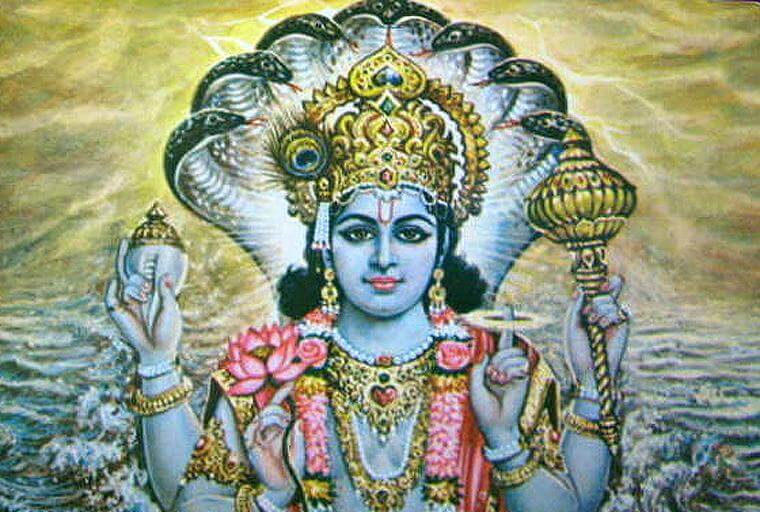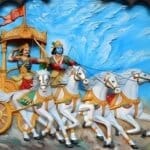Vishnu Avatars and Their Lessons According to Hinduism, one of the primary gods who takes on many guises to bring about calm in times of turmoil or evil is Lord Vishnu.
Let’s explore the ten avatars and the lessons they bring
Matsya (The Fish)
Matsya, the fish, was Vishnu’s first incarnation. The tale states that Matsya rescued the ancient texts, known as the Vedas, from a massive flood that flooded the earth. He led the sage and the holy books on a king’s boat to safety.
Matsya’s message is that, even in the most trying circumstances, knowledge and wisdom must be maintained. In order to preserve what is precious in life, we occasionally have to adjust to harsh circumstances.
Kurma (The Tortoise)
When the ocean was churned by the gods and demons to extract the nectar of immortality (amrita), Kurma, the tortoise, emerged. To maintain Mount Mandara, which served as a churning rod, Vishnu assumed the shape of a tortoise.
Lesson: The secret to doing great things is steadiness and patience. Perseverance enables us to accomplish our objectives, even when life appears to be sluggish or challenging.
Varaha (The Boar)
The Earth had been drowned in the cosmic ocean, but Vishnu saved it in the shape of a pig. He slew Hiranyaksha, a demon who had pulled the Earth to the ocean floor, and returned it to its proper position in the cosmos.
Lesson: Even in the face of formidable obstacles, there are moments when we must stand up for justice and bring about order. We can conquer significant challenges with courage and strength.
Narasimha (The Man-Lion)
The demon king Hiranyakashipu, who was impervious to death by either man or beast, seemed to be vanquished by the man-lion, Narasimha, who was a half-lion, half-man form. The prophecy was fulfilled when Narasimha ripped the demon to pieces at the entrance to his castle.
Narasimha teaches us that the almighty will always find a way to keep the virtuous safe. It also teaches that when evil deviates from the universe’s inherent order, it may be eradicated.
Vamana (The Dwarf)
Vishnu assumed the lowly form of Vamana, the dwarf, to defeat Bali, the demon king who had taken over the three planets. After requesting three land paces, Vamana defeated Bali by expanding to encompass the entire cosmos in three steps.
Lesson: Simplicity and humility have great power. Being modest and humble may sometimes yield the most surprising kinds of power.
Parashurama (The Warrior with an Axe)
A Brahmin warrior named Parashurama was born to purge the world of despicable leaders who were abusing their position of authority.
Lesson: When individuals or leaders misuse their position of authority, justice must be done. It teaches us to uphold society’s principles and morals, even when doing so necessitates making difficult choices.
Rama (The Prince of Ayodhya)
The protagonist of the Ramayana, Rama, is renowned for his unrelenting dedication to justice, duty, and honor. It is a story of love, devotion, and sacrifice as he sets out to save his wife, Sita, from the evil king Ravana.
Lesson: Rama’s life teaches us the significance of courage in trying circumstances, the necessity of righteousness (dharma), and our obligations to our families and society.
Krishna (The Divine Cowherd)
One of the most adored avatars, Shri Krishna, is well-known for his lessons in the Bhagavad Gita, where he gives the warrior Arjuna knowledge. Krishna was a clever kingmaker, a kind friend, and a fun youngster.
Lesson: Krishna teaches us the value of unselfish service, dedication, and striking a balance between one’s material and spiritual lives. Hindu philosophy still heavily relies on his teachings on bhakti yoga, or the yoga of devotion, and karma yoga, or the yoga of action.
Buddha (The Enlightened One)
According to several beliefs, the historical Buddha is Lord Vishnu’s eighth avatar. He used the Eightfold Path to teach people how to be aware, compassionate, and free from suffering.
Lesson: The life of the Buddha inspires us to cultivate mindfulness, compassion, and non-attachment. It says that we may conquer pain by practicing meditation and acting morally.
Kalki (The Future Avatar)
Vishnu’s future incarnation is Kalki, who has not yet been born. According to legend, Kalki will make an appearance after the Kali Yuga to vanquish the forces of evil and bring about the restoration of dharma.
Lesson: We learn about hope and the final victory of good over evil from Kalki’s avatar. It also serves as a reminder that equilibrium depends on the natural cycles of creation and destruction.
All About The Article Is
Every one of Vishnu’s incarnations offers insightful teachings that can direct our lives. These lessons assist us in leading a well-rounded, morally upright, and fulfilling life, whether it be by bravery, humility, justice, or dedication. Similar to how the avatars helped restore cosmic order in their time, we may successfully manage the difficulties of the present world by adhering to these precepts.
These avatars offer helpful advice for daily living in addition to enhancing the spiritual lessons of Sanatan Dharma.
Also, Check Shri Krishna’s Teachings for the Modern World.
More Information About Vishnu Avatar.









